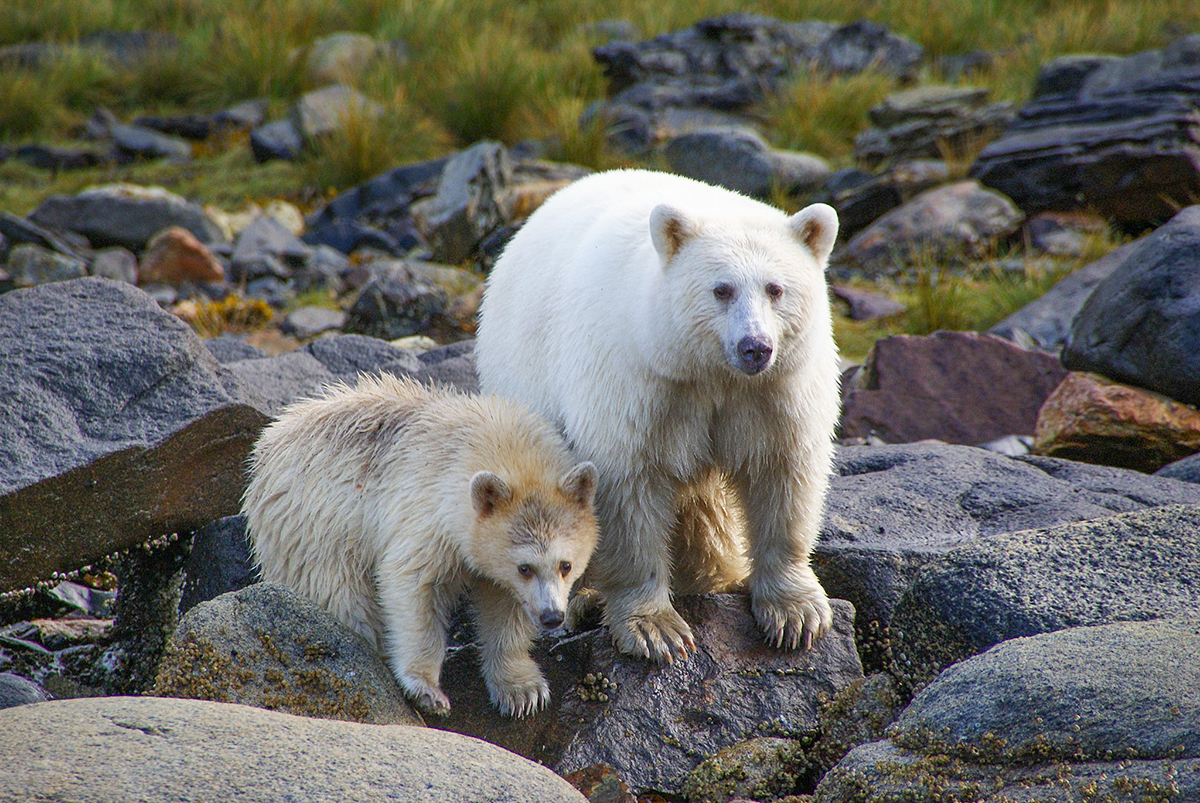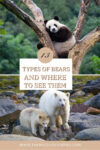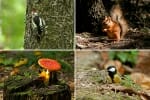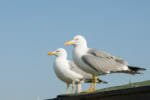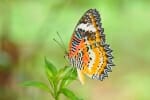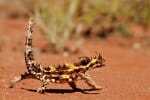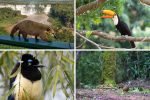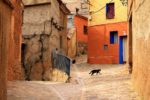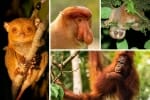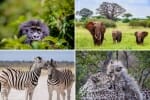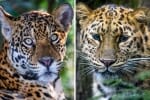Wondering what different types of bears are found around the world? This guide introduces the bear family and shares tips on where to see different types of bears in the wild.
From the enormous Kodiak bear of the Alaskan tundra to the demure tongue-lolling Sun bear of the Malaysian rainforest, bears are as diverse as they are charismatic.
Bears belong to the family Ursidae. The International Union for Conservation of Nature (IUCN) recognizes 8 bear species, each adapted to distinct environments, ranging from the Arctic to the tropical rainforests. Some of the species have up to 16 subspecies. I will keep this guide to the species level and only mention a few other interesting types of bears.
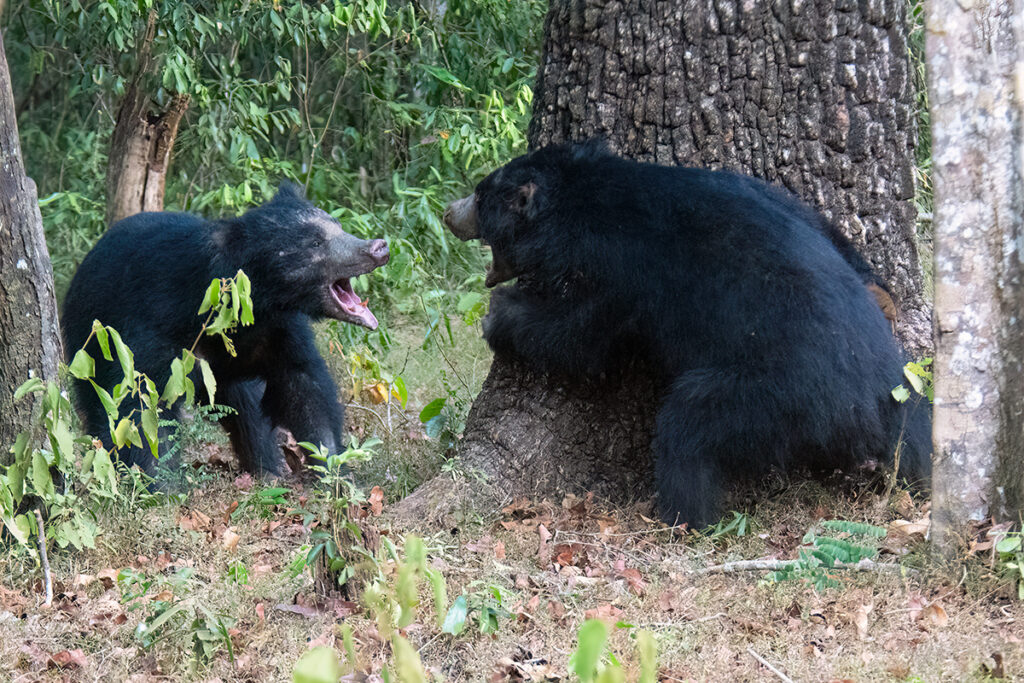
All bears have large bodies, stocky build, and plantigrade gait, meaning that they walk on the soles of their feet.
Bears are fascinating creatures to see in the wild, and many areas of bear habitat have well-developed infrastructure for bear-watching adventures. Some species are easier to see than others, as you will see from my tips for the best places to see different types of bears.
Quick facts about the different types of bears
What are the 8 species of bears?
Brown bear (including grizzly and Kodiak bears, Black bear (including spirit bear), Polar bear, Giant panda, Andean bear, Asiatic black bear, Sun bear and Sloth bear.
What is the biggest bear?
The two largest bears are polar bears and Kodiak bears. Male polar bears typically weigh 350- 600 kg (775-1,300 lb). While Kodiak bears weigh up to 680kg (1,300 lb). So on average, Kodiak bears are slightly larger.
However, Polar Bears International reports a male polar bear from Canada which researchers estimated to weigh around 800 kg (1,700 lb)!
Is the Giant panda a bear?
The debates on whether the giant panda belongs to the family of bears or raccoons raged for decades. Until in 1980s, molecular studies resolved the argument placing the giant panda in the bear family Ursidae.
Brown Bear (Ursus arctos)
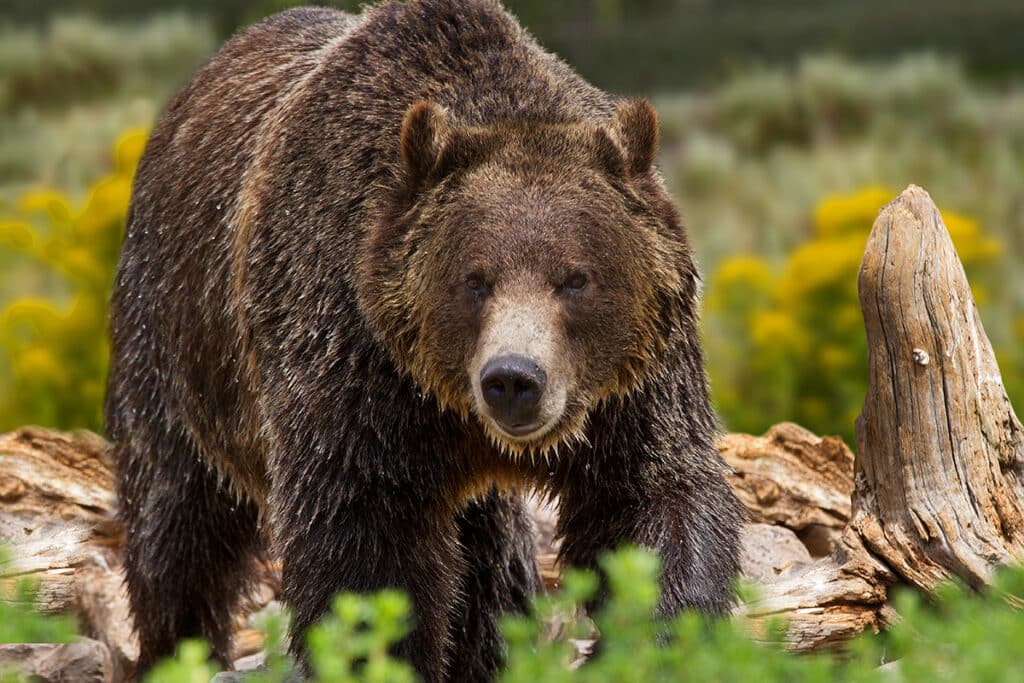
IUCN Status: Least Concern
The brown bear is one of the largest terrestrial carnivores in the world, rivalled only by the slightly larger Polar bear. It roams across large swaths of the US and Canada, Europe and Central Asia. Some subspecies of the brown bear are much larger than others, but generally, these bears weigh from 80 to 600 kg (180 to 1,320 lb).
To maintain their impressive body weight, brown bears spend most of the summer feeding and can put on as much as 180 kg (400 lb) during this time. To preserve their energy in winter when food is scarce, brown bears become lethargic and retreat to their dens that they establish in caves, under large tree roots or overhangs. Contrary to popular belief, brown bears don’t truly hibernate and can be easily awakened from their slumber.
Where to see brown bears: In Europe, the best place to see and photograph brown bears is Martinselkonen Nature Reserve in Finland.
Grizzly Bear (Ursus arctos horribilis)
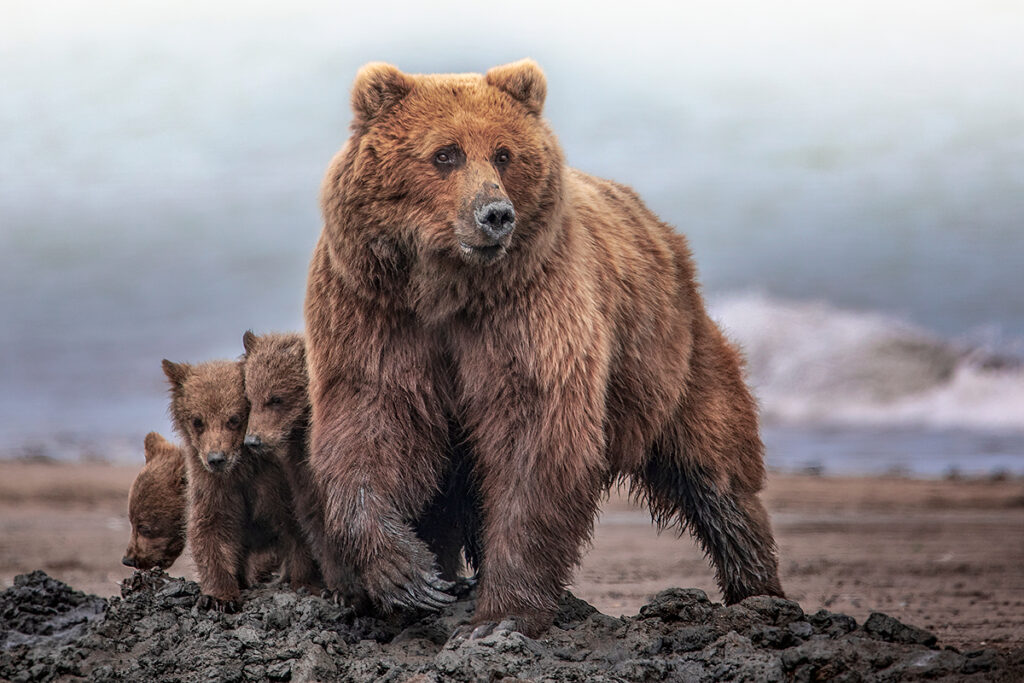
The term “grizzly bear” is typically applied to brown bears in North America. As the story goes, when early American naturalists discovered the bear, they didn’t recognise it as the Brown bear of Europe and Asia and thought it was a uniquely American animal. They named it grizzly for the grizzled appearance of its coat. Since then, brown bears in North America have been known as grizzlies.
Where to see grizzly bears: By far, the best place to see grizzly bears is the Alaskan Peninsular. Out of about 60,000 wild grizzly bears in North America, half live in Alaska. And Alaskan grizzlies are massive. Males can grow to almost 400 kg, with females about half their weight.
Of all Alaskan National Parks, Katmai is the best for bear-watching in Alaska. Visit from June to July and watch bears fish for salmon at Brook Falls. You can find more details in our guide to Katmai Bear watching. Lake Clark National Park is another good spot for watching grizzlies as well as other Alaskan wildlife.
In the lower states, Yellowstone National Park is a great spot for finding grizzly bears, particularly around Lamar Valley. While in Canada, wildlife tours in the Canadian Rockies offer a decent chance of spotting a grizzly.
Kodiak Bear (Ursus arctos middendorffi)
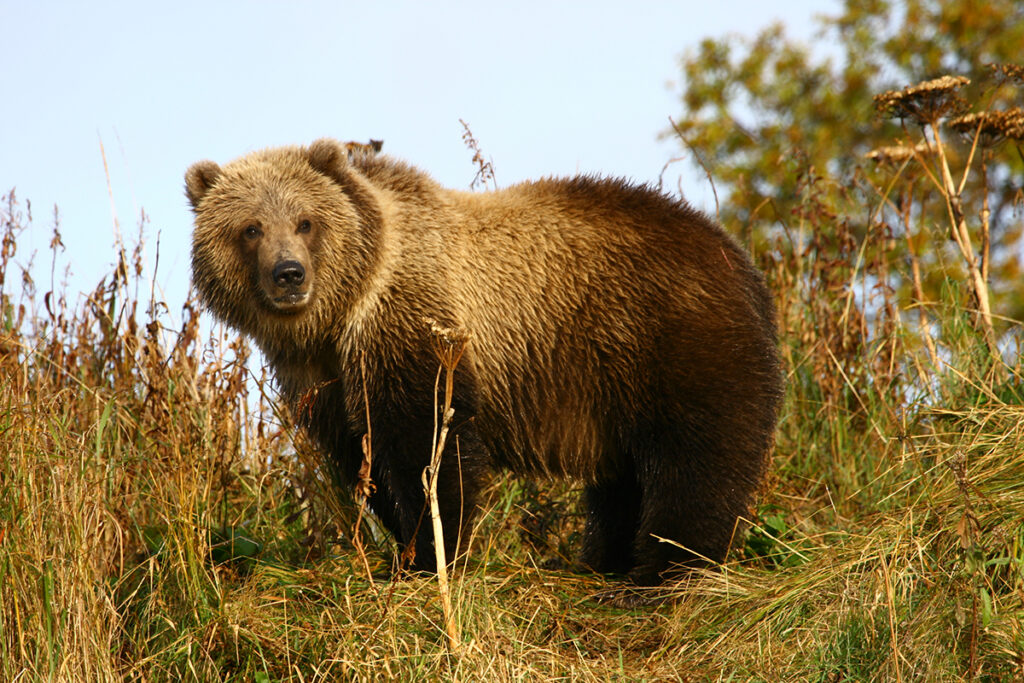
Brown bears or grizzlies living on the islands of the Kodiak Archipelago in Alaska have been isolated from their mainland cousins by at least 12,000 years. In that time, they became sufficiently different from the mainland brown bears to be classified as a distinct subspecies.
These bears are enormous, on average 1.5 to 2 times larger than other brown bears in North America. Kodiak bears weigh anywhere from 300 to 600 kg (660 to 1,320 lb). The largest recorded Kodiak bear was Clyde, who lived at the Dakota Zoo until 1987. When he died at the age of 22, Clyde weighed 966 kg (2,130 lb).
Curiously, despite their enormous size, Kodiak bears have some of the smallest home ranges among brown bears. This is probably due to the uniquely productive ecosystem of the Kodiak Archipelago. The richness of the ecosystem is probably the reason for the bears’ size. That, plus the absence of competition.
Beyond their size, Kodiak bears do not differ significantly from the mainland grizzlies. They keep a similar diet and retreat to their dens in winter.
Where to see Kodiak bears: Kodiak Island is the best place in the archipelago to see the bears. There are several options available for bear-viewing tours, including ‘on the road’ tours, as well as float plane trips, boat trips, and ATV excursions.
North American Black Bear (Ursus americanus)
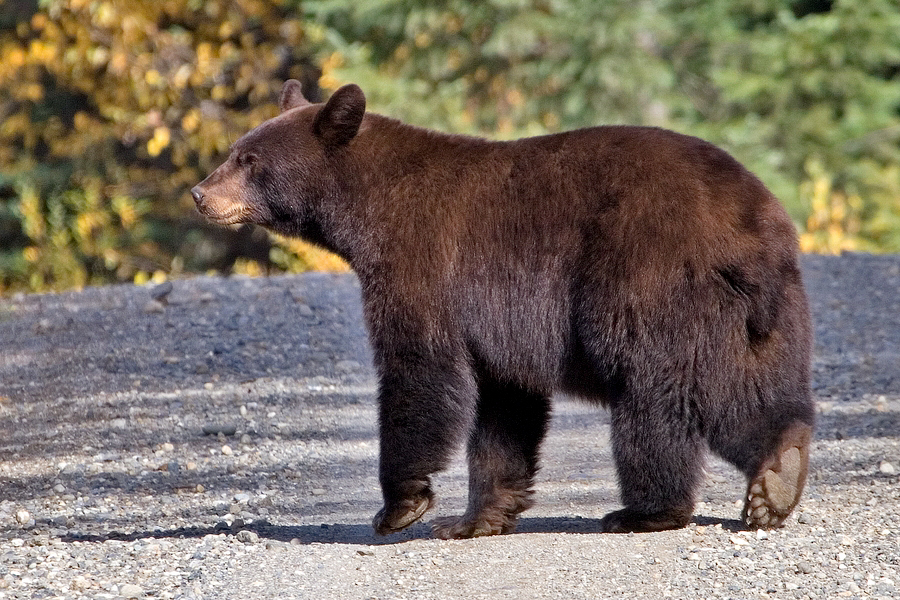
IUCN Status: Least Concern
The North American black bear is a medium-sized bear native to North America, although it is not always black. Some black bears are actually white, others are cinnamon, and some are blue. More on these colour morphs below.
Black bears can weigh up to 250 kg (551 lb), with males heavier than females. In areas where both black and brown bears occur, black bears can be distinguished by their smaller size and longer ears. Their claws are not as long, which is handy for identifying their tracks.
Like grizzlies, black bears are omnivores. They spend their summers eating and their winters sleeping.
Where to see black bears: One of the best places to see black bears are Canada’s west coast, particularly in the Tofino district on Vancouver Island.
In the US, Yellowstone National Park, Great Smoky Mountains National Park, and Alligator River National Wildlife Refuge are among the best places to spot black bears in the wild.
Spirit Bear (Ursus americanus kermodei)
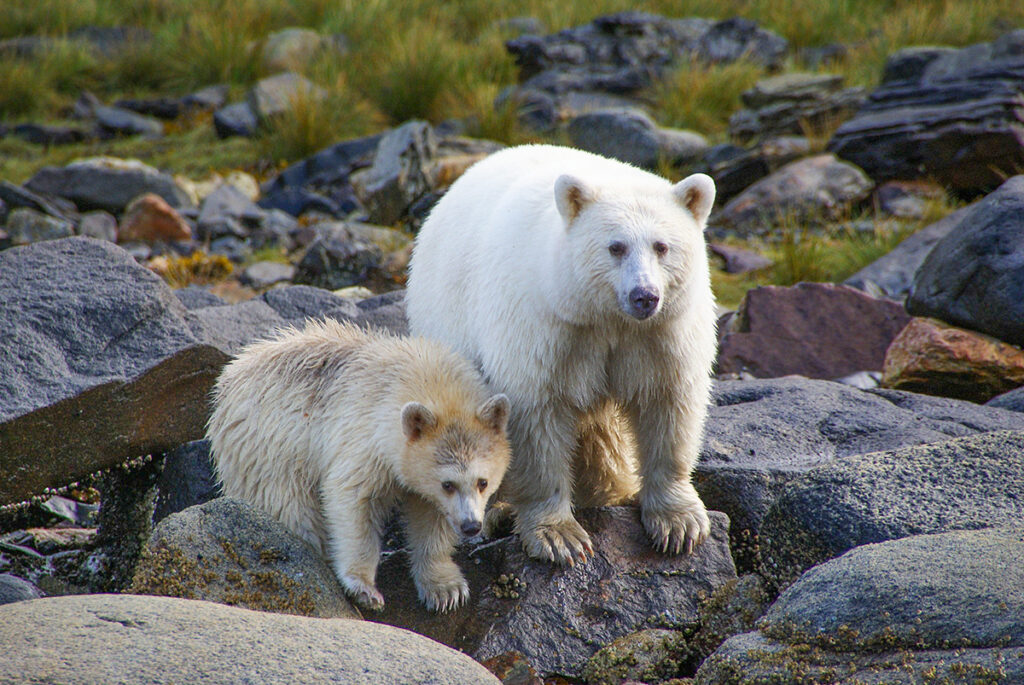
Canada’s Great Bear Rainforest in British Columbia is home to the unusual cream or white-coloured black bears, known as Spirit bears or Kermode bears. White bears owe their colouration to a double recessive gene, much like white wallabies on Bruny Island in Australia.
Not all Kermode bears are white, but on the islands of Gabriel, Princes Royal, and Roderick, white morphs comprise about 10-20 percent of the populations.
Where to see spirit bears: The remote islands of the Great Bear Rainforest on the North Coast of British Columbia are the only place in the world where you can find “white” black bears. White bears are rare, and seeing one is a chance of a lifetime.
Cinnamon Bear (Ursus americanus cinnamomum)
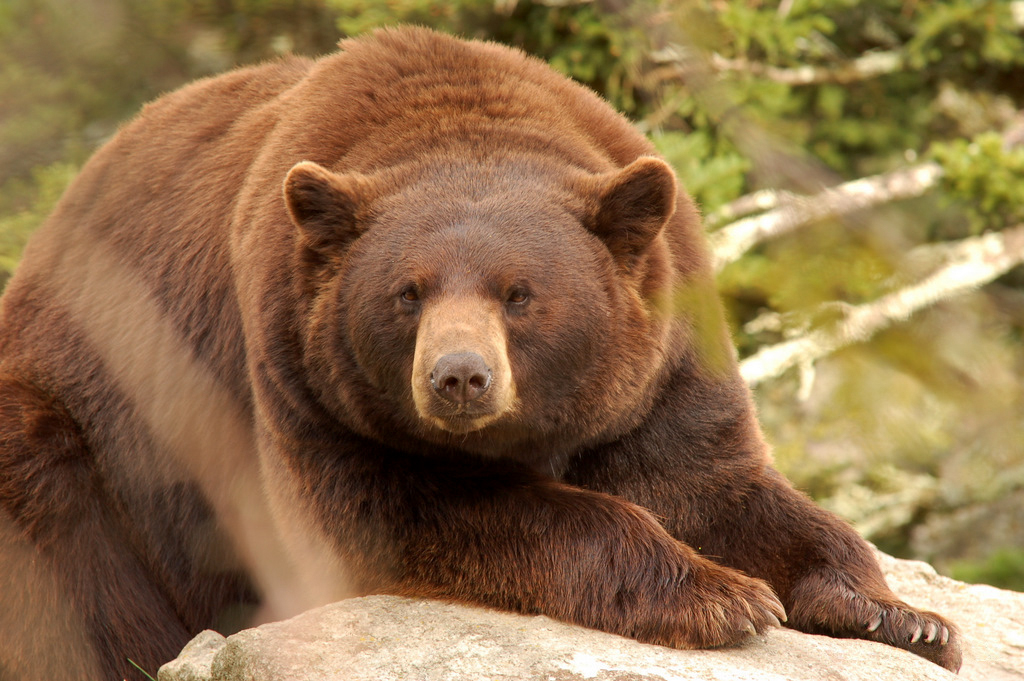
Cinnamon bears are technically black bears, but they have brown or red-brown fur. They occur alongside black-coloured black bears largely in and around the Rocky Mountains.
Recently scientists discovered that the cinnamon fur colour is due a genetic mutation that happened millennia ago. It is actually the same mutation that’s responsible for the amber coat of the grizzly.
The reason for this mutation’s success is not yet know but there are some interesting theories. One is that it would’ve been advantageous for black bears to mimic grizzlies as it would’ve given them a competitive edge to be mistaken for a stronger, larger type of bear.
A more traditional view is that the mutation causing cinnamon fur color could be a case of crypsis—an ability to avoid detection by blending with the environment. A cinnamon coat would better match the open Southwest landscape than a black coat.
Where to see cinnamon bears: Cinnamon bears are becoming more common which increases your chances of spotting them across their range in and around the Rocky Mountains.
Blue Bear (Ursus americanus emmonsii)
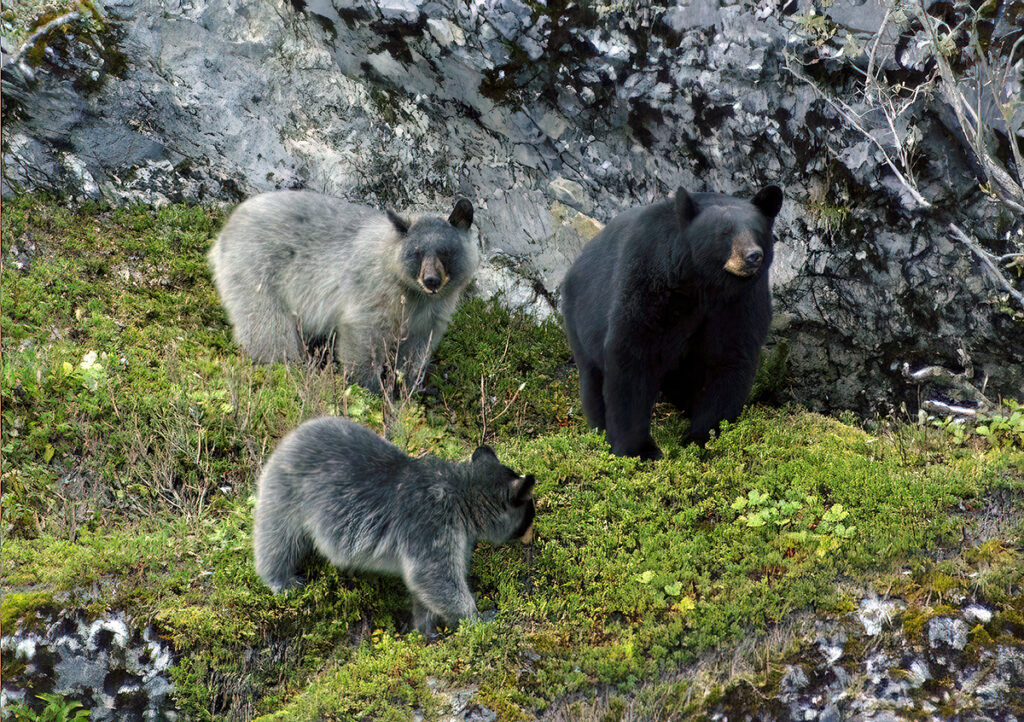
As far as unusual types of bears go, blue bear, also known as a Glacier bear is one of the rarest animals on Earth and by far the rarest type of bear, although it is not a unique species.
Found only in northern Southeast Alaska and a small portion of western Canada, these bears are so uncommon that not much is known about them. Blue bears occur among some black bear populations but not all. Where they do occur, cubs with blue coat can be borne to black-colored mothers, like in the image above.
Where to see Glacier bears: Seeing a Glacier bear is no easy feat, but if you wish to try your luck, Glacier Bay National Park is a good place to start.
Polar Bear (Ursus maritimus)
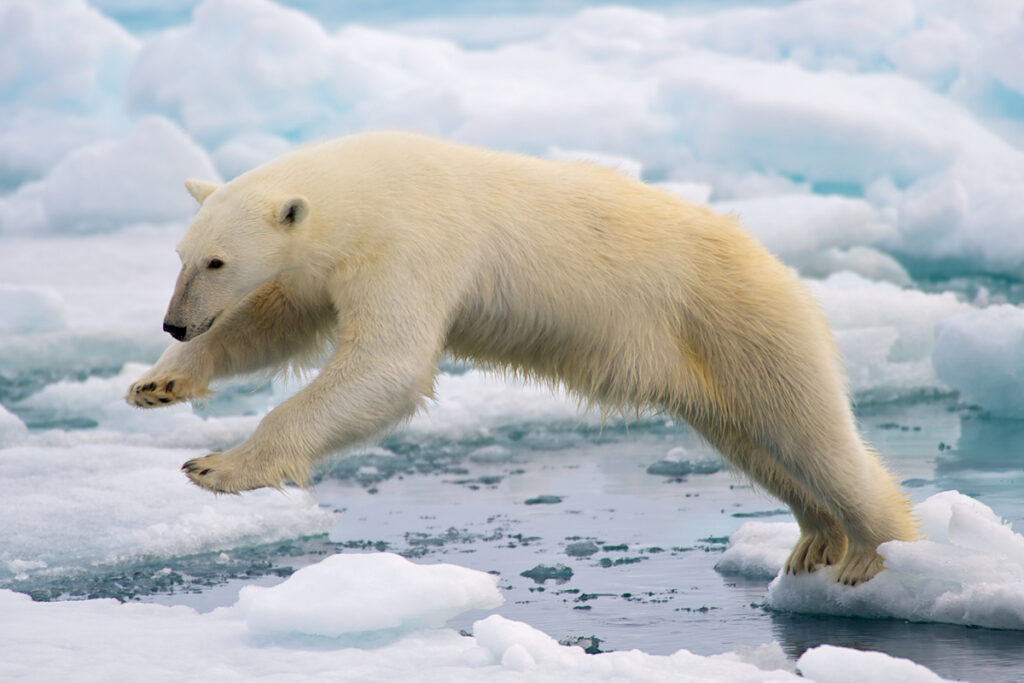
IUCN Status: Vulnerable
The polar bear is one of the two largest types of bears on Earth (the other is Kodiak). Generally, Kodiak bears tend to be a little heavier than polar bears, although one of the largest bears on record is a male polar bear in Canada that researchers estimated to weigh around 800 kg (1,700 lb).
Polar Bears live in the ice-covered waters of the circumpolar Arctic, where winter temperatures can plunge to -40° or -46 C (-50 F). But the bears are well adapted to those conditions.
To start with, polar bears have 2 layers of dense fur. Beneath that fur, polar bears are further insulated with a layer of fat up to 11.4 cm (4.49 in) thick.
Relatedly, polar bears have massive paws – up to 30 cm (11.81 in) across that let them walk on thin ice without breaking it. Much like the huge feet of the Canada lynx enable them to walk on the surface of the snow without falling through.
Where to see polar bears: The best place to see polar bears in the wild is in the area around the town of Churchill in Manitoba, Canada. You can learn more in my guide to watching polar bears in Churchill.
Giant Panda (Ailuropoda melanoleuca)
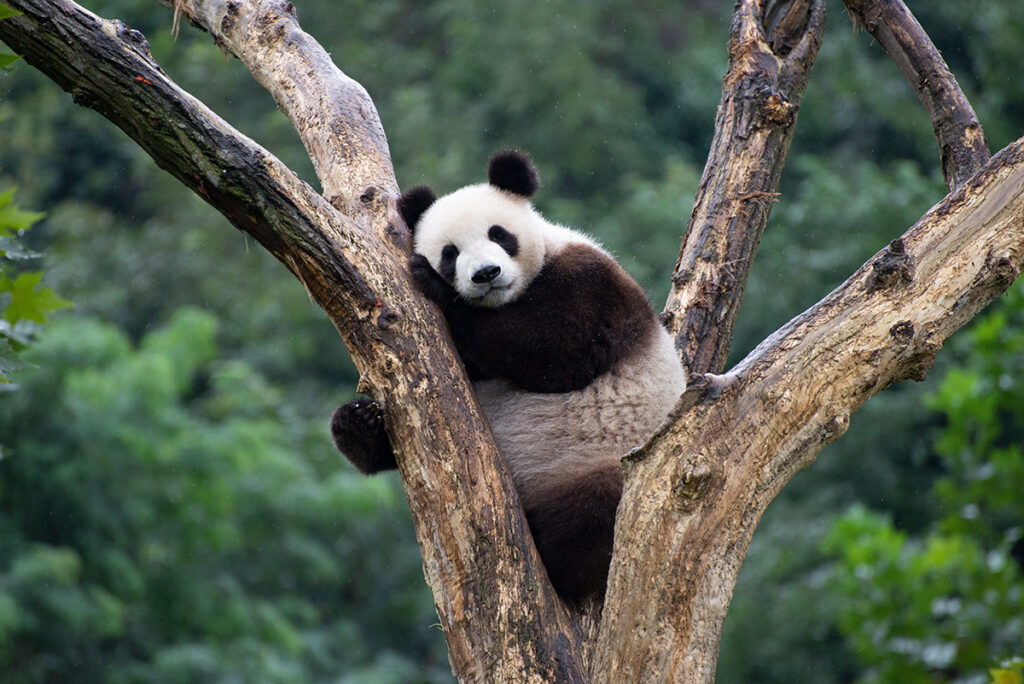
IUCN Status: Vulnerable
The giant panda is endemic to the bamboo forests of China. It once ranged across southern and central China and into Southeast Asia, but today, these charismatic animals remain in a handful of populations scattered between Sichuan, Gansu, and Shaanxi Provinces.
The giant panda is the rarest bear species, and once it was one of the most endangered mammals on Earth. After an intensive and very high-profile conservation effort, Giant panda numbers are believed to be increasing, with 1,864 individuals estimated at the last population census.
Giant panda is one of the most herbivorous bear species with bamboo comprising 99 percent of its diet. This means that an average Giant panda needs to spend about 14 hours a day eating, consuming up to 12.5 kg of bamboo a day.
Where to see giant pandas: To try your luck at spotting a Giant panda in the wild you can join an organized tour, like this one with Royale Sarafis.
Asiatic Black Bear (Ursus thibetanus)
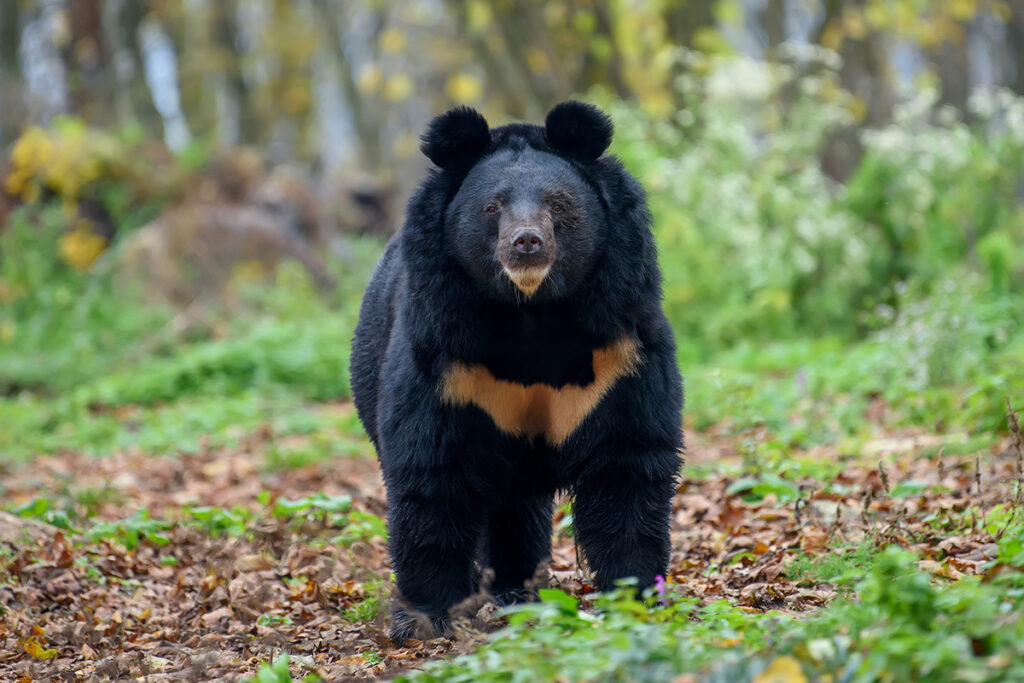
IUCN Status: Vulenrable
The Asiatic black bear was once found as far west as France and Germany, but today, the species is confined predominantly to Asia, from Iran across the Himalayan foothills to Southeast Asia, north through China to the Russian Far East.
Asiatic black bears have a characteristic cream or white v-shaped collar, which earned them the name of “moon bears.”
Like their American cousins, Asiatic black bears have brown and white or ‘blond’ colour morphs, but they are rare. Unlike their American counterparts, however, Asiatic black bears are decreasing in number mainly due to habitat loss.
Where to see the Asiatic black bears: Tangjiahe National Park in Sichuan, China, appears to be a good place to see them, though sightings are not frequent.
Andean Bear (Tremarctos ornatus)
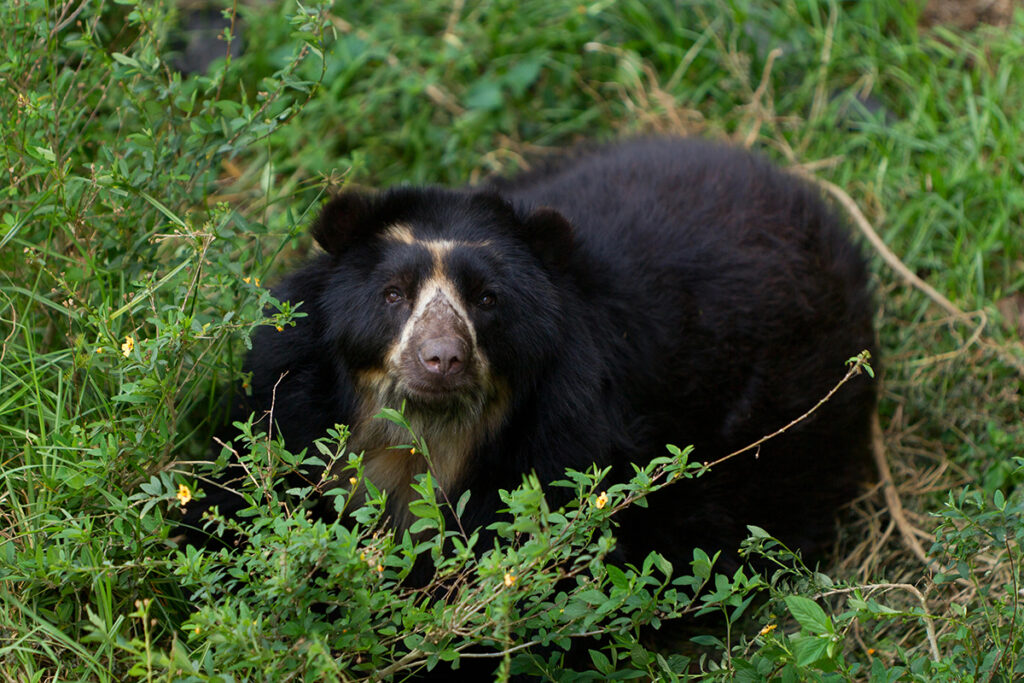
IUCN Status: Vulnerable
The Andean bear of South America, also known as the spectacled bear, is distinguished from other bears by the rings of white or cream fur around its eyes and cheeks, which contrast with the bear’s otherwise uniformly black or dark brown fur.
This is a shy bear who tends to avoid contact with humans. This makes the Andean bear difficult to study, and not surprisingly, little is known about its life in the wild. Even the total population size of these bears is not well-known, with estimates ranging from 2,500 to 10,000 individuals remaining in the wild. There is, however, little doubt that the species is in decline across its remaining range in the Andean countries from Venezuela to Bolivia.
Where to see Andean bears: Ecuador has the highest density of Andean bears and is the best country for spotting them in the wild. For the highest chance of success, head to Maquipucuna Cloud Forest Reserve & Ecolodge, a couple of hours’ drive from Quito.
Sun Bear (Helarctos malayanus)
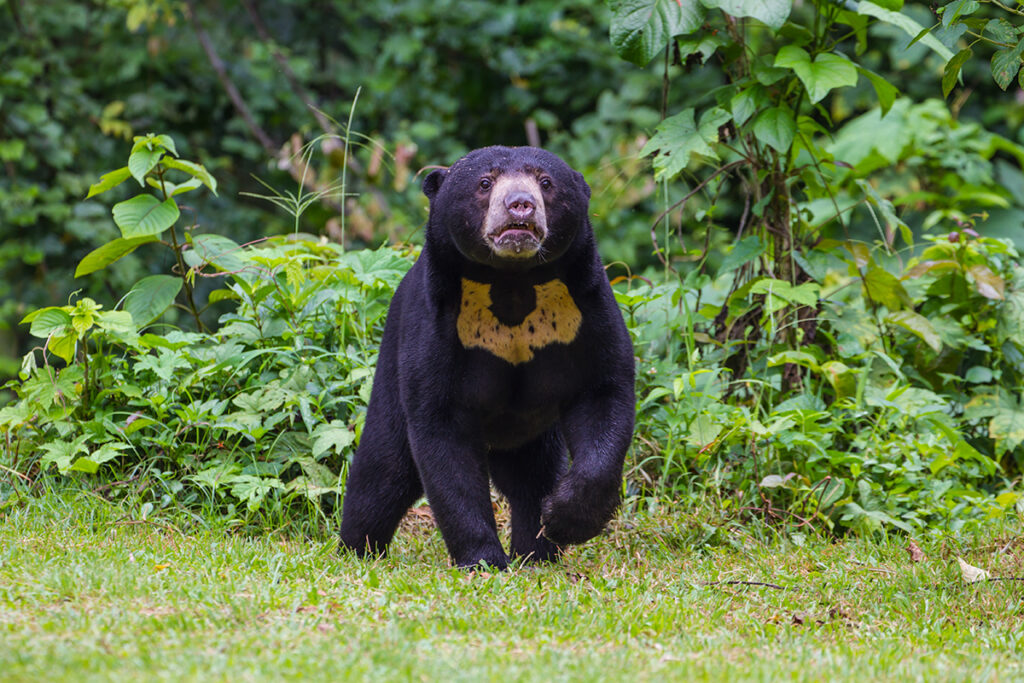
IUCN Status: Vulnerable
The smallest bear species, sun bears can weigh less than 50 kg (110 pounds). Sun bears have short, sleek, black coats that keep them cool in the tropical heat. But their most well-known characteristic is probably their extraordinarily long (25 cm) tongues.
Sun bears are probably the least-known bear species. They occur throughout Asia but no one knows how many sun bears there are. They are declining throughout their range even in protected areas like Khao Yai National Park in Thailand.
Where to see sun bears: The closest I came to spotting a sun bear was seeing its tracks in Deramakot Forest Reserve in Borneo. They are seen in Deramakot somewhat regularly during the fruiting season.
Sloth Bear (Melursus ursinus)
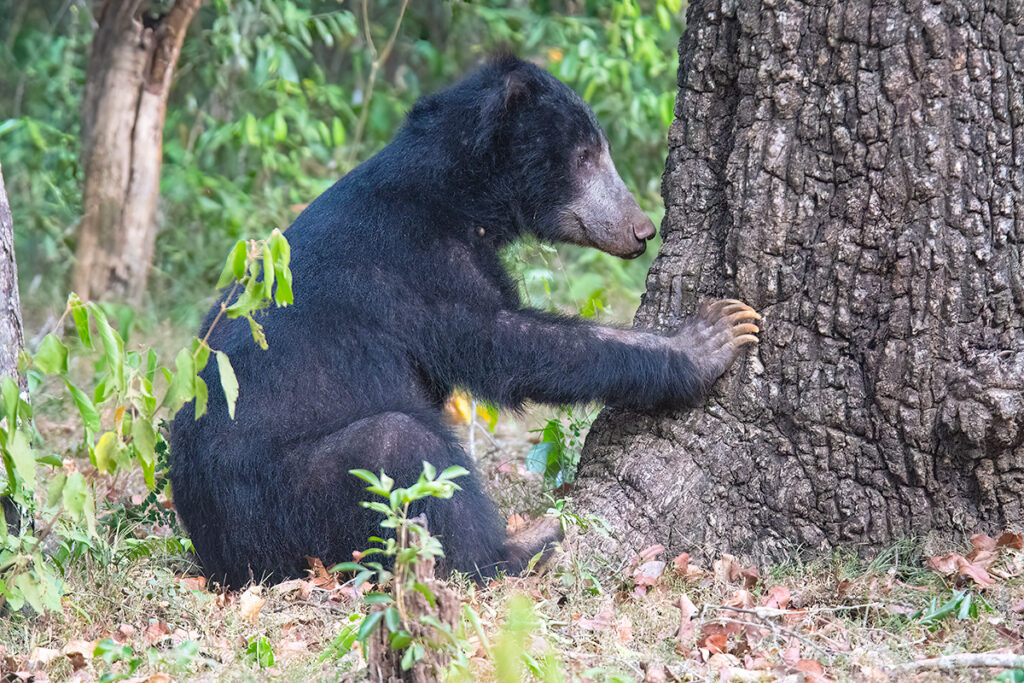
IUCN Status: Vulnerable
Sloth bears are termite specialists with long, shaggy fur and very long claws that they use to dig into termite mounds. These bears occur on the Indian subcontinent, preferring areas rich in termite mounds.
Because of sloth bears’ fondness for termites, they tend to walk around with their nose to the ground, sniffing for termites. And since they are not looking around, predators, like tigers, are able to sneak up on them quite easily. Consequently, when sloth bears notice a tiger in close proximity, they often react with aggressive outbursts.
Where to see sloth bears: The best place to see sloth bears is Wilpattu National Park in Sri Lanka. We witnessed a dispute between two bears in the park, which was accompanied by very non-bear-like squealing.
And there you have it, 13 different types of bears, including 8 known species of bears and several particularly interesting subspecies and local variations.
More Wildlife Guides
- Wildlife of Moscow Parks: Birds, Mammals, and Amphibians
- The striking world of moths of Thailand
- Finding Birds in Istanbul without Looking for Them
- The Diverse and Spectacular Butterflies of Thailand
- Uluru animals – Weird and wonderful creatures you can spot at Uluru
- Wildlife of Iguazu Falls, Brazil and Argentina
- Stray cats vs free-roaming cats: How to tell the difference?
- 28 Incredible Borneo Animals and best places to see Borneo wildlife
- What are the best African Safari Holidays Destinations?
- Jaguar vs Leopard – Discover How to Tell the Two Cats Apart

